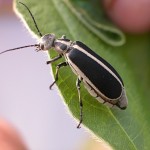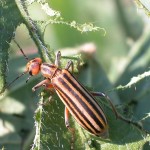Occasionally, you catch a blister beetle in a sweep net sample in Tennessee soybeans. These large, showy adult beetles may also feed in clusters and defoliate the plants. Defoliation of soybeans in an area a big as a pickup truck is not a concern, but if it occurs over a large area, such as the size of a barn, treatment is warranted. Refer to PB 1768 for control options.
Blister beetles are members of the insect family Meloidae. This family includes over 300 North American species and more than 2500 species worldwide. Blister beetles get their name because when disturbed, they secrete a defensive toxin called cantharidin from glands at their leg joints, which may cause blisters or even oozing lesions upon contact with skin. This defense mechanism is referred to as “reflex bleeding”. So please, do not handle these insects! Also, cantharidin is highly toxic when ingested and irritates the gastrointestinal and urinary tracts of animals and may lead to death, especially in horses. Therefore, blister beetles are a concern to hay producers throughout Tennessee.
Adult blister beetles in the large genus Epicauta eat leaves but their larvae eat grasshopper eggs. Striped (E. vittata) and margined blister beetles (E. pestifera) are in this genus and are fairly common in Tennessee. Since they feed on the foliage of soybeans, vegetables, pasture grasses and other crops, these are among the few insects that may be pests as adults, but beneficial as larvae.
An interesting bit of history about cantharidin is that for centuries it was used as a cure for a variety of ailments. One famous species of Spanish blister beetle, called the Spanish fly (Lytta vesicatoria L.) is sometimes harvested, dried, ground, and sold for medicinal and other purposes. Spanish fly has been infamous since Roman times as an aphrodisiac with considerable powers. But do not try this at home. Less than one thousandth of an ounce of cantharidin is enough to cause severe kidney damage or even death.
References:
Kinney, K. K., F. B. Peairs and A. M. Swinker. 2010. Blister Beetles in Forage Crops. Colorado State Ext.
Factsheet no. 5.524. Accessed 2-13-15. http://www.ext.colostate.edu/pubs/insect/05524.html
Marshall, S. A. 2006. Insects: Their Natural History and Diversity. Firefly Books Ltd. Buffalo, NY 14205. Pgs. 272-273.




2 thoughts on “Interesting Insects: Blister beetles”
Comments are closed.